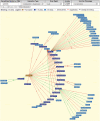FlyBase: integration and improvements to query tools
- PMID: 18160408
- PMCID: PMC2238994
- DOI: 10.1093/nar/gkm930
FlyBase: integration and improvements to query tools
Abstract
FlyBase (http://flybase.org) is the primary resource for molecular and genetic information on the Drosophilidae. The database serves researchers of diverse backgrounds and interests, and offers several different query tools to provide efficient access to the data available and facilitate the discovery of significant relationships within the database. Recently, FlyBase has developed Interactions Browser and enhanced GBrowse, which are graphical query tools, and made improvements to the search tools QuickSearch and QueryBuilder. Furthermore, these search tools have been integrated with Batch Download and new analysis tools through a more flexible search results list, providing powerful ways of exploring the data in FlyBase.
Figures




Similar articles
-
FlyBase: anatomical data, images and queries.Nucleic Acids Res. 2006 Jan 1;34(Database issue):D484-8. doi: 10.1093/nar/gkj068. Nucleic Acids Res. 2006. PMID: 16381917 Free PMC article.
-
FlyBase: genomes by the dozen.Nucleic Acids Res. 2007 Jan;35(Database issue):D486-91. doi: 10.1093/nar/gkl827. Epub 2006 Nov 11. Nucleic Acids Res. 2007. PMID: 17099233 Free PMC article.
-
FlyBase 101--the basics of navigating FlyBase.Nucleic Acids Res. 2012 Jan;40(Database issue):D706-14. doi: 10.1093/nar/gkr1030. Epub 2011 Nov 29. Nucleic Acids Res. 2012. PMID: 22127867 Free PMC article.
-
FlyBase : a database for the Drosophila research community.Methods Mol Biol. 2008;420:45-59. doi: 10.1007/978-1-59745-583-1_3. Methods Mol Biol. 2008. PMID: 18641940 Review.
-
Using FlyBase, a Database of Drosophila Genes and Genomes.Methods Mol Biol. 2016;1478:1-31. doi: 10.1007/978-1-4939-6371-3_1. Methods Mol Biol. 2016. PMID: 27730573 Free PMC article. Review.
Cited by
-
Drosophila Ringmaker regulates microtubule stabilization and axonal extension during embryonic development.J Cell Sci. 2016 Sep 1;129(17):3282-94. doi: 10.1242/jcs.187294. Epub 2016 Jul 15. J Cell Sci. 2016. PMID: 27422099 Free PMC article.
-
Automatic, context-specific generation of Gene Ontology slims.BMC Bioinformatics. 2010 Oct 7;11:498. doi: 10.1186/1471-2105-11-498. BMC Bioinformatics. 2010. PMID: 20929524 Free PMC article.
-
A regulatory circuit for piwi by the large Maf gene traffic jam in Drosophila.Nature. 2009 Oct 29;461(7268):1296-9. doi: 10.1038/nature08501. Epub 2009 Oct 7. Nature. 2009. PMID: 19812547
-
Resources for functional genomics studies in Drosophila melanogaster.Genetics. 2014 May;197(1):1-18. doi: 10.1534/genetics.113.154344. Epub 2014 Mar 20. Genetics. 2014. PMID: 24653003 Free PMC article. Review.
-
Discovering structural cis-regulatory elements by modeling the behaviors of mRNAs.Mol Syst Biol. 2009;5:268. doi: 10.1038/msb.2009.24. Epub 2009 Apr 28. Mol Syst Biol. 2009. PMID: 19401680 Free PMC article.
References
-
- Sturtevant AH. A history of genetics, Harper and Row, New York. New York: Harper & Row; 1965. pp. 45–50.
-
- Drosophila 12 Genomes Consortium. Evolution of genes and genomes on the Drosophila phylogeny. Nature. 2007;450:203–218. - PubMed
-
- Mungall CJ, Emmert DB. A Chado case study: an ontology-based modular schema for representing genome-associated biological information. Bioinformatics (Oxford, England) 2007;23:i337–i346. - PubMed
Publication types
MeSH terms
Grants and funding
LinkOut - more resources
Full Text Sources
Molecular Biology Databases

